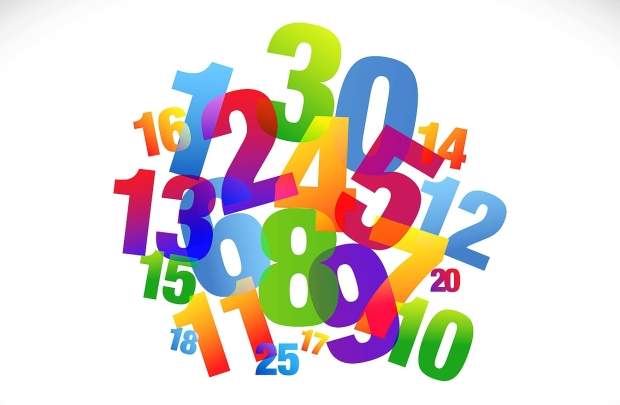Table of Contents
MATH CONCEPTS
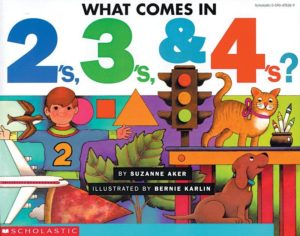 |
Suzanne Aker’s What Comes in 2s, 3s, and 4s (Aladdin, 1992) in a picture-book introduction to sets – starting with your own two eyes, two ears, two arms, and two legs. For ages 2-5. |
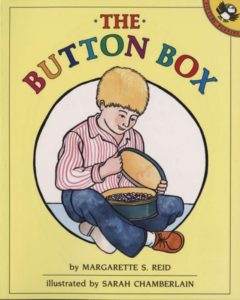 |
In Margarette S. Reid’s The Button Box (Puffin, 1995), a little boy gets out his grandmother’s enormous button box and begins to play, sorting the buttons into rows and piles – all the flower-painted china ones, all the sparkly jewel-like ones, and so on. There’s not much to it, but it would be great paired with an actual button box. (Got one?) For ages 3-6. |
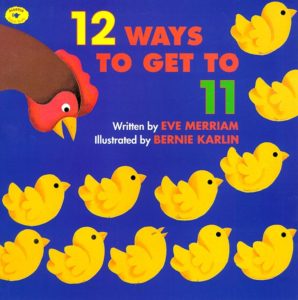 |
Eve Merriam’s 12 Ways to Get to 11 (Aladdin, 1996) is a clever twist on the counting book, showing 12 different combinations of things that all add up to 11: 9 pine cones and 2 acorns, for example; or 4 flags + 5 rabbits + 1 pitcher of water + 1 bouquet of flowers, all pulled from a magician’s hat. For ages 3-7. |
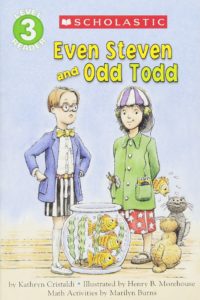 |
In Kathryn Cristaldi’s Even Steven and Odd Todd (Cartwheel, 1996), Steven is definitely odd, in that he insists everything come out even, from his breakfast pancakes to the fish in his goldfish bowl. Then cousin Odd Todd arrives, who prefers his numbers odd. Eventually all works out – and the book ends with a handful of questions and simple activities on even and odd numbers. For ages 4-8. |
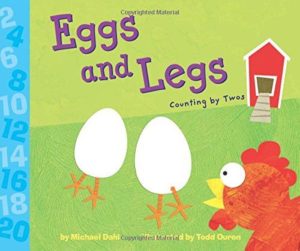 |
Michael Dahl’s Eggs and Legs (Nonfiction Picture Books, 2005) is a clever exercise in learning to count by twos, as a hen watches pairs of legs emerge from hatching eggs. Also see Dahl’s Lots of Ladybugs: Counting by Fives and Toasty Toes: Counting by Tens. For ages 4-8. |
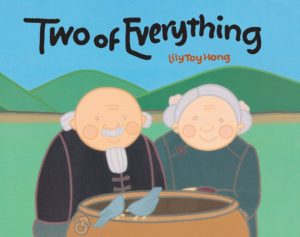 |
In Lily Toy Hong’s Chinese folktale Two of Everything (Albert Whitman & Company, 1993), Mr. Haktak unearths an ancient pot in the garden that turns out, miraculously, to double anything placed inside it. He and Mrs. Haktak happily double their money (again and again), but then Mrs. Haktak herself falls into the pot. And doubles. For ages 4-8. |
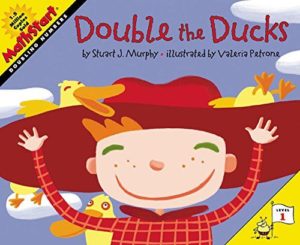 |
In Stuart J. Murphy’s Double the Ducks (HarperCollins, 2002), a pint-sized cowboy is caring for his flock of five ducks. Then each duck brings home a friend, which means twice as much food, twice as much bedding, and twice as much work. For ages 4-8. |
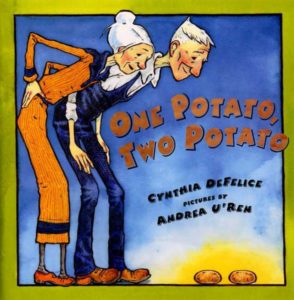 |
Cynthia DeFelice’s One Potato, Two Potato (Farrar, Straus & Giroux, 2006) is an Irish version of the doubling story, in which Mr. and Mrs. O’Grady are so ragged and poor that they have only one of everything – one potato for dinner, one blanket on their bed, one chair to sit in, and one winter coat. Until, that is, Mr. O’Grady finds a magic pot, that doubles everything put inside. For ages 4-8. |
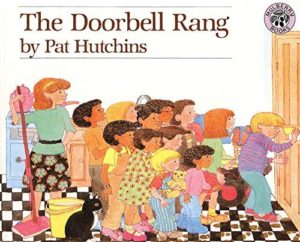 |
In Pat Hutchins’s The Doorbell Rang (Greenwillow, 1989), Sam and Victoria have just divided one dozen of their mother’s freshly baked cookies, when the doorbell starts ringing and more and more friends arrive. With each new guest, the dozen cookies must be divided all over again. An exercise in beginning division (and sharing) for ages 4-8. |
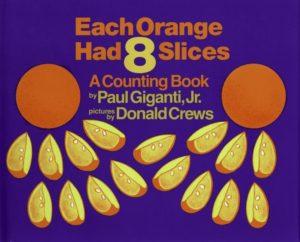 |
Paul Giganti’s Each Orange Had Eight Slices (Greenwillow, 1999) is a simple picture-book introduction to counting, addition and, by extension, multiplication. (“On my way to the zoo I saw 3 waddling ducks. Each duck had 4 baby ducks trailing behing, Each duck said, “QUACK, QUACK, QUACK.” So: how many ducks, how many baby ducks, how many quacks? For ages 4-8. |
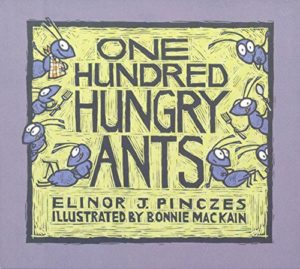 |
In Elinor J. Pinczes’s One Hundred Hungry Ants (Houghton Mifflin Harcourt, 1999), a tale of division, one hundred ants are headed toward a picnic when they are halted by one mathematically minded ant, who suggests that they will get food more efficiently if they split up into ranks. Obediently the ants rearrange themselves in groups of 50, 25, 10, and so on – only to discover by the time they’ve finished that the picnickers have packed up and left. For ages 4-8. |
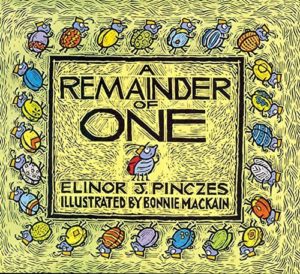 |
Also by Pinczes is A Remainder of One (Houghton Mifflin Harcourt, 2002), in which the ants struggle to form even ranks to march in the big parade. For ages 4-8. |
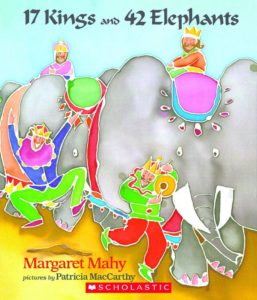 |
Margaret Mahy’s rhyming 17 Kings and 42 Elephants (Dial, 1987) features a royal procession through the jungle in which 17 kings and 42 elephants meet a tongue-twisting array of animals. A fun romp with potential for problem-solving. (How to divide 42 elephants among 17 kings?) For ages 4-8. |
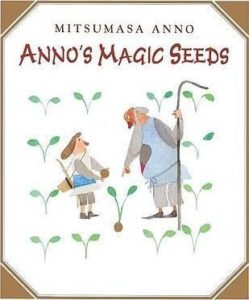 |
In Mitsumasa Anno’s Anno’s Magic Seeds (Puffin, 1999), Jack meets a wizard who gives him two golden seeds, telling him to plant one and eat the other (“You will not be hungry again for a whole year”). Jack does, and the seed grows into a lovely blue-flowered plant that produces two seeds. Eventually Jack decides to eat something different for a change, and so plants both seeds, getting two plants and a harvest of four seeds. This time he eats one and plants three – and things rapidly multiply, becoming more and more complicated. For ages 4-8. |
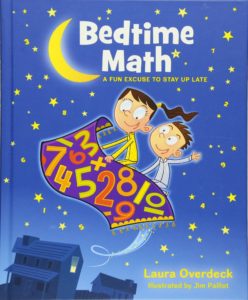 |
Laura Overdeck’s Bedtime Math series (Felwel & Friends) is a curiosity-provoking approach to math with fun fact-crammed problems centered around everything from jalapeno peppers and squirting ketchup bottles to roller coaster rides, crayons, marshmallows, and ladders to the moon. For each, there are questions targeted at wee ones, little kids, and big kids. A great family program that emphasizes how math is a part of everyday life. |
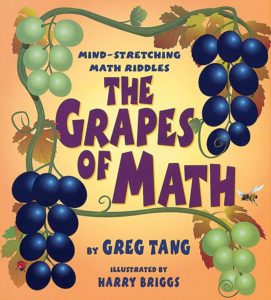 |
Greg Tang is a master of math riddles, and his books – written in catchy rhyme – encourage kids to identify patterns and combinations and to devise effective problem-solving strategies. Titles include The Grapes of Math (Scholastic, 2004), Math for All Seasons, and Math Potatoes. For ages 4-8. |
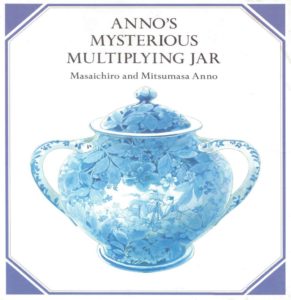 |
By Masaichiro Anno and Mitsumasa Anno, Anno’s Mysterious Multiplying Jar (Penguin Putnam, 1999) is a wonderful introduction to the concept of factorials through the medium of a blue-and-white Oriental jar. The jar, opened, contains an ocean in which there are two islands. Each island has two countries; each country has three mountains; on each mountain, there are four walled kingdoms; and so on. A gorgeous multiplication problem ending up with a phenomenal number of jars. For ages 4-8. |
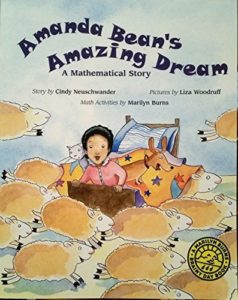 |
Amanda Bean, main character of Cindy Neuschwander’s Amanda Bean’s Amazing Dream (Scholastic, 1998), loves to count, but she’s not at all interested in learning her multiplication facts. Until, that is, she has a dream in which eight sheep on bicycles each buy five balls of yarn, and the resultant counting confusion reveals the usefulness of learning how to multiply. The book’s cartoon-style illustrations are crammed with things to count (and multiply), from lollipops to windowpanes to puffy bushes in the park. For ages 5-8. |
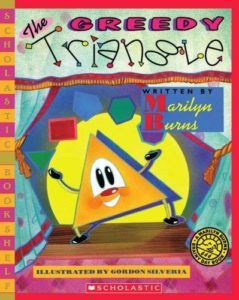 |
In Marilyn Burns’s The Greedy Triangle (Scholastic, 1998), the greedy triangle wants more than just three sides and three angles. With the help of the local shapeshifter, he acquires more and more, becoming in turn a quadrilateral, pentagon, hexagon, heptagon, and octagon before finally deciding that life as a triangle was really the best of all. For ages 4-8. |
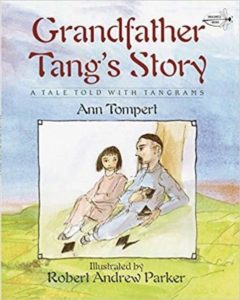 |
In Ann Tompert’s Grandfather Tang’s Story (Dragonfly, 1997), a Chinese grandfather tells his little granddaughter a story about a pair of magical shape-changing foxes, illustrating the story with geometrical tangram puzzle pieces. The book includes a reproducible tangram template for making a set of your own. For ages 4-8. |
| From ABCYa.com, Tangrams for Kids has tangram puzzles to solve online. Click and drag to rearrange the shapes. | |
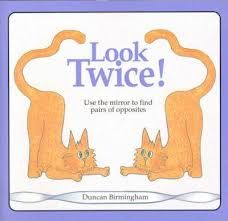 |
In Duncan Birmingham’s Look Twice (Tarquin, 1993), readers use an enclosed mirror card to turn a pair of identical objects into a pair of opposites. A fun study in symmetry for ages 4-8. |
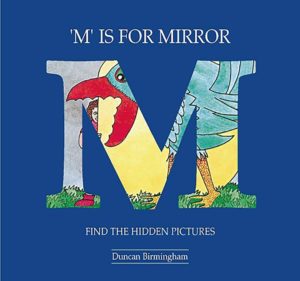 |
Also see Birmingham’s M is for Mirror (Tarquin, 1988). |
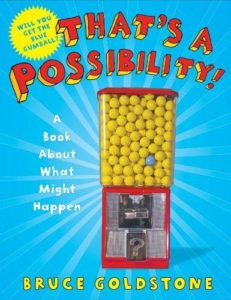 |
Bruce Goldstone’s That’s a Possibility! (Henry Holt and Company, 2013) is an introduction to probability, using an interactive question-and-answer format and bright color photographs to discuss concepts of possible, probable, improbable, and certain. For example, a teddy bear has ten shirts and ten pairs of pants, which combine to make 100 different outfits – so it’s unlikely (100 to 1) that anyone can correctly guess what outfit he’s going to wear. For ages 5-9. |
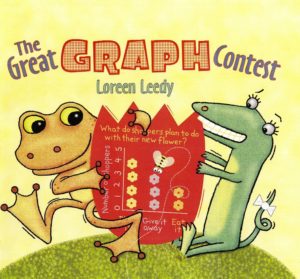 |
In Lauren Leedy’s The Great Graph Contest (Holiday House, 2006), Chester (a snail) is monitoring a contest between friends Beezy (a lizard) and Gonk (a toad) over who can make the best graph. In the process, the friend explore data collection processes and many different kinds of graphs, among them bar graphs, pie graphs, pictographs, and Venn diagrams. For ages 5-8. |
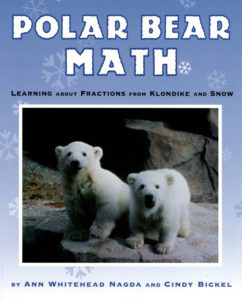 |
Ann Whitehead Nagda’s Polar Bear Math (Square Fish, 2007) is a real-life exercise in fractions based on data from two polar bear cubs born at the Denver Zoo. Each double-page spread includes a page of data – how to mix polar-bear formula, for example – while the facing page tells the story of the bears, illustrated with photographs. For ages 6-9. |
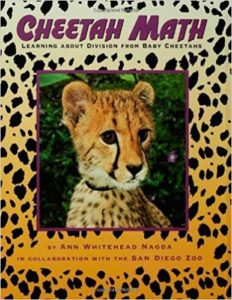 |
Also by Ann Whitehead Nagda, in Cheetah Math (Henry Holt and Company, 2007) kids learn division with real-life data from a pair of cheetah cubs; Tiger Math (Square Fish, 2002) in which kids learn to graph by tracking the growth of a tiger cub; and Chimp Math (2002), in which readers learn to keep time records. |
| Check out 10 Best Books for Teaching Graphs. |
